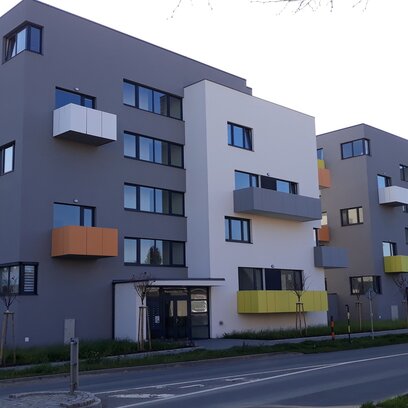In general, colour influences our perception of our surroundings, is an important design element and has the ability to evoke different emotional responses in people. In architecture, colour is then used to create atmosphere and accentuate different elements of a building. Therefore, the choice of colour is also important. However, high demands are placed on facade colours throughout the year as they must be able to withstand all weather conditions. What do we require from a facade paint? It's simple, we need longevity and colour fastness. This all depends on the characteristics of the facade system, including the facade paint.
The most important property of the facade paint is vapour permeability, which allows water vapour to escape through the structure. Therefore, currently mainly silicate and silicone paints are used. Both of these paints can be used on almost any type of facade. Silicate paint has excellent vapour permeability because it is bonded with potassium glass. However, its disadvantage is its poorer flexibility and water repellency. Silicone paint has better properties in terms of water repellency, flexibility and breathability and is suitable for a variety of surfaces. Compared to traditional facade coatings, silicone facade paint offers better weather resistance, long life and high efficiency.
Among the top products on the market is the premium Cemix Silicone Facade Paint with fibres, which stands out for its particularly high vapour permeability (class V1) and moisture resistance (w < 0.2 kg/m2.h0.5) and is primarily intended for exterior use. The formulation of this premium coating is based on a balanced and field-proven combination of silicone, which guarantees vapour permeability, polymer dispersions (which are two-phase waterborne systems) and bioactive agents that are retained in microcapsules and gradually released. The consequence is a very strong surface protection against mould and algae. The coating is also reinforced with fibres which give it greater strength and at the same time the ability to prevent cracks. When rehabilitating older facades, this property also has the positive effect of reliably smoothing out previously formed micro-cracks. Cemix Silicone Facade Paint also relies on the photocatalytic effect (the transformation of chemicals by light) to reduce the risk of contamination.
The silicone facade paint can only be applied to a compact, dry and dust-free surface that shows no signs of biotic attack. If the coating is applied on an absorbent substrate, it is necessary to apply Cemix 2614 deep primer beforehand to harden the surface and unify its absorbency. The facade coating can only be processed at temperatures between 5 °C and 30 °C. The paint consumption is of course dependent on the absorbency of the substrate, but on average ranges from 0,3 to 0,5 kg/m2. It is applied undiluted by roller or brush, usually in two coats.
Silicone facade paint with fibres is able to protect the facade from damage and pollution in the long term, while maintaining its colour stability. Thanks to its water-repellent properties, it is also successfully used in plaster restoration and renovation of historic buildings. It is suitable for all types of insulation, i.e. for both polystyrene and mineral wool based systems. The builder can choose from 360 shades and two types of packaging (8 and 24 kg).


